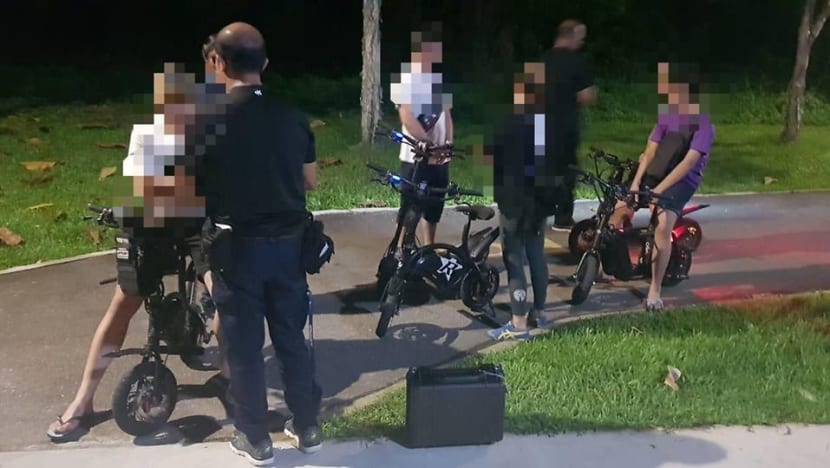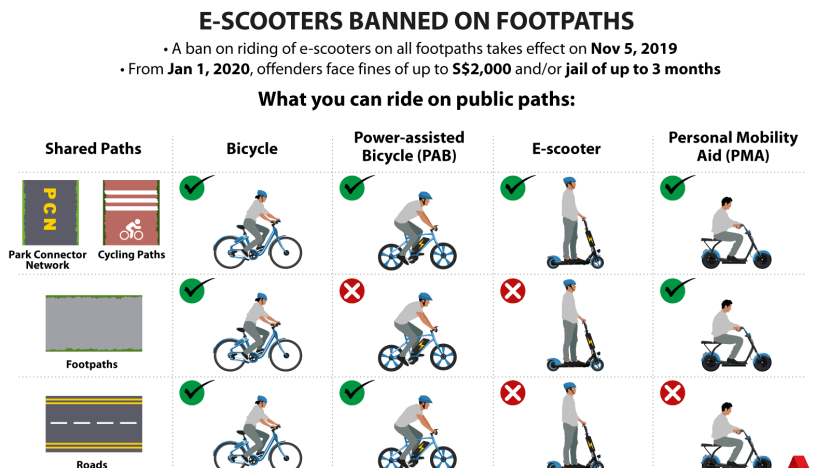E-scooter ban on footpaths: 5 things you need to know

Eleven devices were impounded by the Land Transport Authority during the enforcement operation in Punggol on May 17, 2019. (Photo: Land Transport Authority)
SINGAPORE: Electric scooters will be banned from footpaths in Singapore from Tuesday (Nov 5), Senior Minister of State for Transport Lam Pin Min announced in Parliament on Monday.
Dr Lam described it as a "difficult decision" but he added that it was "a necessary step" for the safety of pedestrians on public paths.
However, he stressed that this change "is not a complete ban of e-scooters".
READ: E-scooters to be banned from Singapore's footpaths starting Nov 5
Here is what you need to know on the latest announcement:
1. What happens if you're caught riding an e-scooter on a footpath?
E-scooters will be banned from footpaths from Tuesday, but to allow riders to adjust to the new regulations, there will be an advisory period till the end of the year.
Until Dec 31, errant users will be given warnings.
From 2020, there will be a “zero-tolerance” approach taken, the Land Transport Authority (LTA) said.
From Jan 1, 2020, those caught riding an e-scooter on footpaths will be liable for a fine up to S$2,000 and/or jail up to three months.
READ: Commentary: Can we co-exist with PMDs? Yes, but we need to take a different path
2. Where can you ride your e-scooter?
You can only ride your e-scooters on cycling paths and park connector networks. They remain banned on roads.
There will be dedicated cycling paths as well where e-scooters can still be used.
Several cycling path projects are nearing completion in major towns, according to LTA.
From next year, residents in Ang Mo Kio, Bishan, Bukit Panjang, Taman Jurong and Tampines will have greater active mobility connectivity as sections of cycling paths in these neighbourhoods will be completed, the authority added.
There are about 440km of such paths islandwide currently, and this is expected to gradually extend to a total of 750km by 2025 and triple by 2030.
By 2030, all HDB towns will have a cycling path network, LTA added.
3. Does this ban only apply to e-scooters?
For now, it’s just e-scooters. But by the first quarter of next year, other types of PMDs, such as hoverboards and electric unicycles, are also expected to be banned from footpaths.
The ban will not apply to bicycles or personal mobility aids such as motorised wheelchairs or mobility scooters, Dr Lam said in Parliament.

READ: Commentary: Don’t complain about rules for bikes and PMDs until we’ve proven we can be responsible
READ: PMDs could be banned if rider behaviour does not improve: Janil Puthucheary
4. How will this affect other services using e-scooters?
On the food delivery sector, Dr Lam said less than 30 per cent of Deliveroo and FoodPanda riders use e-scooters.
LTA will still work with such companies to help their riders switch to motorcycles or bicycles instead, he added.
PMD-sharing services will be affected too.
LTA will reject existing licence applications for PMD-sharing services, and no new applications for such licences will be accepted because of safety concerns.
5. Can I still dispose of non-compliant e-scooters?
LTA offered in September cash and free disposal of PMDs which do not meet new fire-safety standards.
The authorities are now extending the early disposal incentive scheme - where S$100 is given for the disposal of non-UL2272 compliant registered e-scooters - to the end of the year.
The UL2272 standard refers to a set of safety requirements which cover the electrical drive train system of PMDs, including the battery system.
Of the 100,000 registered e-scooters, at least 80,000 are not UL2272-certified and cannot be used on all public paths from Jul 1, 2020, when all PMDs have to meet the safety certification, LTA said.














